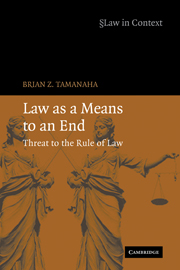Book contents
- Frontmatter
- Contents
- Acknowledgments
- Introduction
- Part 1 The spread of legal instrumentalism
- 1 Non-instrumental views of law
- 2 A changing society and common law in the nineteenth century
- 3 Nineteenth-century legislation and legal profession
- 4 Instrumentalism of the legal realists
- 5 Twentieth-century Supreme Court instrumentalism
- Part 2 Contemporary legal instrumentalism
- Part 3 Corroding the rule of law
- Epilogue
- Index
- Titles in the series
4 - Instrumentalism of the legal realists
Published online by Cambridge University Press: 25 July 2009
- Frontmatter
- Contents
- Acknowledgments
- Introduction
- Part 1 The spread of legal instrumentalism
- 1 Non-instrumental views of law
- 2 A changing society and common law in the nineteenth century
- 3 Nineteenth-century legislation and legal profession
- 4 Instrumentalism of the legal realists
- 5 Twentieth-century Supreme Court instrumentalism
- Part 2 Contemporary legal instrumentalism
- Part 3 Corroding the rule of law
- Epilogue
- Index
- Titles in the series
Summary
The close of the nineteenth century and the opening of the twentieth was a period of great intellectual ferment. A burst of academic works spewed forth portraying law and politics as the battleground among competing groups; their common theme was the “seemingly pervasive influence of economic interests” on government. This was the core thesis of Arthur Bentley's The Process of Government (1908) and Charles Beard's controversial An Economic Interpretation of the Constitution (1913). Beard's book was notorious because he tossed mud on the national myth built around the iconic Founding Fathers, arguing that their primary motivation when constructing the Constitution was to advance the economic interests of merchants, large property owners, and creditors, groups in which they were members.
A new intellectual radicalism emerged at the turn of the century, into which these works fit. Historian Christopher Lasch identified the various sources of this emergence:
Everyone who has studied the history of American reform agrees that the reform tradition underwent a fundamental change around 1900. Some people identify the change with a changing attitude toward government, a new readiness to use government (particularly the federal government) as an instrument of popular control. Others associate it with an abandonment of the old populistic distrust of large-scale institutions, like corporations, and an acceptance of the inevitability of the concentration of wealth and power. Still others define the change as a movement away from the dogma of natural rights toward a relativistic, environmentalist, and pragmatic view of the world. All of these developments, in truth, were going on at the same time, and all of them contributed to the emergence of the new radicalism.
- Type
- Chapter
- Information
- Law as a Means to an EndThreat to the Rule of Law, pp. 60 - 76Publisher: Cambridge University PressPrint publication year: 2006

